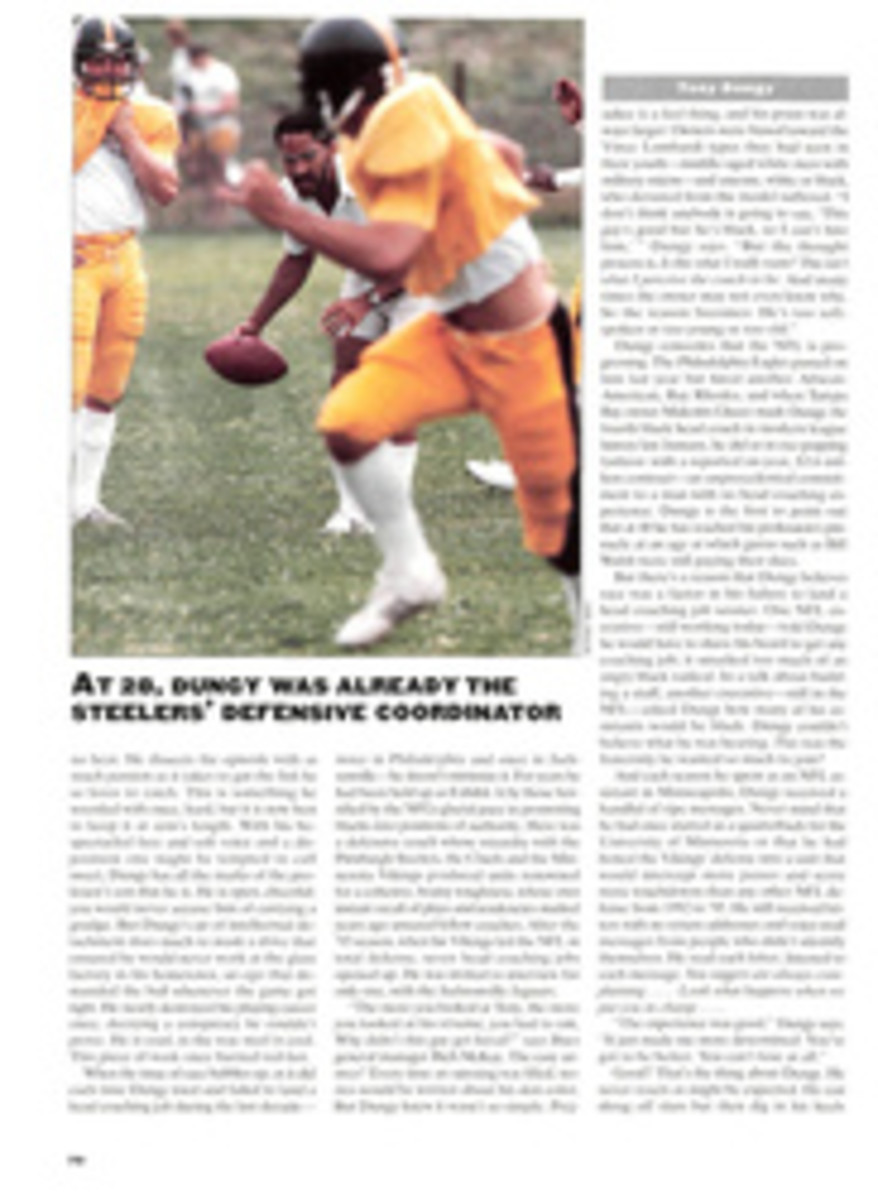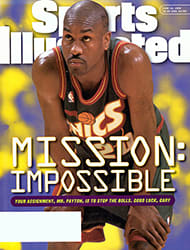
THE KILLER SERVE THAT IS MICHELLE GOULD'S BIG WEAPON, AND VIRTUALLY NO OPPONENT SURVIVES IT
The winningest player in racquetball history prepares to serve.
Michelle Gould stands at the line, facing the court's side wall
in what seems like prayerful meditation, and slowly steps into a
crouch that resembles a deep genuflection. With her upper body
now parallel to the floor and a mere two feet above it, Gould
holds the ball solemnly in front of her, balancing it on her
cupped fingertips as if offering it up in sacrifice. She
carefully brings the racket back, then gingerly steps forward.
And strikes. The speed of the ball is startling, especially
after such a mesmerizing windup. Gould's serve has been clocked
at 167 mph. "No one can return it, and so the ball is really
never put into play," says Hank Marcus, who organized the
Women's International Racquetball Tour Pro Nationals on April
24-27 in Las Vegas, where Gould won the $3,000 first prize with
ease. Indeed, Gould's serve usually rockets along the side wall
just inches above the floor, burrows into the corner and finally
rolls out, unreturned.
On the strength of this delivery, the 25-year-old Gould has won
111 professional and amateur tournaments since 1983, amassed
career winnings of more than $400,000 and been named to every
U.S. national team for the past 12 years. She dominates her
sport much as Babe Didrikson Zaharias once ruled golf and
Martina Navratilova lorded over tennis--or perhaps even more so.
Gould's opponents are lucky to win a point, never mind a game.
Says U.S. national coach Jim Winterton, "Michelle is the best,
man or woman, to ever play this game."
Gould was raised in the tiny town of Ontario, in east-central
Oregon, on a farm with goats, pigs, horses and chickens. "It was
a great way to grow up," she says. "When I wasn't running around
outside, I was helping out with the chores. I learned a lot
about responsibility."
Not to mention tenacity. At age nine she was at a 4-H
competition at the local fairgrounds when, in the center ring, a
randy bull made advances toward her cow, Shorty. "She freaked,"
Gould says of the cowed cow, which ran off, with Michelle
holding tight to the lead line. "I was afraid Shorty might hurt
someone, so I refused to let go, even though this cow was
dragging me through the dirt and scraping me against the arena
fence." Her stubbornness was rewarded by the judges. Bloodied
and muddied, Michelle accepted the show's Grand Champion ribbon.
Several months later her parents, Larry and Brenda Gilman, gave
Michelle a membership at a local health club for her 10th
birthday. The idea was to find an activity that the family,
including her older brother, Jon, could enjoy together.
Racquetball was the answer. They started visiting the health
club every day. "We'd all get in a court and swat the ball
around," says Gould. Actually, in the beginning Michelle mostly
swatted air. She was so bad that one time the family counted her
whiffs: Michelle dropped the ball, swung and missed 47 times
before making contact. Her father wisely suggested that she sign
up for lessons at a health club in Boise, Idaho, a 45-minute
drive from Ontario.
"She was absolutely terrible," says Nick Hansen, her first
instructor. "In one lesson Michelle hit the ball twice. It was
the longest hour of my life. Afterward I went up to her dad and
said, 'Larry, I don't think she's ever going to learn to play
this game.'" The very words to make a stubborn soul more
determined.
Michelle spent hours alone in a court doing drills. The next
year she won her first junior tournament, even though she could
hit only forehands. She still has the tournament's
hot-dog-shaped trophy. Three years later, at age 14, she became
the youngest player ever named to the national team. Because she
regularly beat the best women in the state, Michelle started
practicing with and playing against men. That is how she honed
her power game: the booming serve and then the put-away. In some
open tournaments she actually competed against men. "I was
karate-chopped in the neck, I was tripped, and I heard all the
trash talk," she says. "You can't believe what some guys will do
just so they don't lose to a kid." But lose to her they did.
Even more impressive than Michelle's victories over men was her
concentration. Animated and gregarious off the court, she
adopted a Bjorn Borg-like stoicism during her matches,
projecting all the warmth and emotion of an ice tray. She still
does so today. "Michelle has incredible mental strength," says
Winterton. "She once told me that if she concentrates hard
enough, she can will the ball to go where she wants. I've seen
it. I believe her."
Her mastery of racquetball began as the game's popularity peaked
in the mid-1980s. In those years the sport was the bread and
butter of health clubs, and participation climbed to about 18
million players. Michelle decided to postpone going to college,
and she turned pro just as the game's general appeal started to
decline.
But now bell-bottoms are back, and retro is hip, which might
help to explain racquetball's quiet renaissance. Participation
is inching back up--nine million players is the current
figure--and last spring, in an episode of Friends, Chandler and
Joey shared their angst through a few points on a racquetball
court. Michelle, of course, is still winning.
In 1992 she married Rod Gould, a recreational player who is now
her coach and manager, and when they're not traveling to
tournaments, they call Boise home. She spends 20 weeks a year on
the road. And even after winning everything in her sport, she
finds challenges and goals in it.
Her most impressive accomplishment was winning the gold medal in
the Women's Open singles at the Pan American Games in Buenos
Aires last spring. (By putting her pro winnings in a trust fund
that she draws on to pay for her training, Gould can maintain
her dual pro-amateur status, which allows her to compete in
international amateur events.) Hours after touching down in
South America, Gould caught a virus that sent her temperature up
to 104[degrees]. For a week she went from her hotel bed to her
matches, played, wrapped herself in cold towels and headed back
to bed.
"People have so much respect for what she's accomplished," says
Gould's doubles partner, Cheryl Gudinas, who lost to her in the
finals in Vegas. "Right now no one playing thinks she can beat
Michelle. It's mental. No one even expects to win." Not long ago
one player was so intimidated by having to play Gould that in
the middle of the match she threw up.
In fact, Gould has been so invincible that other women players
have said she should again take the court against men. The men
may not agree. "Michelle's incredibly talented--and powerful,"
says John Ellis, who has hit with Gould and is ranked fifth in
the world. "She also has great court sense. But the top men
still hit the ball harder, and their game is more aggressive."
Gould, for her part, prefers to stay focused on her game and on
her role as racquetball's goodwill ambassador. She works with an
organization called AmPro, certifying racquetball instructors
and conducting clinics in the U.S. and abroad. She is also
lobbying hard, on behalf of the American Amateur Racquetball
Association, to make racquetball an Olympic sport. "I was in
Sydney last summer, talking to the organizing committee for the
2000 Games," she says. "We couldn't convince them to include
racquetball, but we're not giving up. Competing in the Olympics
is my dream."
For now Gould will have to settle for being No. 1 in the women's
racquetball world. But IOC officials should take note of the
champion's determination. As those 4-H judges learned years ago
when Shorty was chased by a bull, Michelle doesn't let go
easily.
Lisa Twyman Bessone lives in Santa Fe, N.Mex., where she works
for Outside magazine.
COLOR PHOTO: BILL BAPTIST When she started out, Gould had no backhand. Now the shot is a feared part of her arsenal. [Michelle Gould playing racquetball]
COLOR PHOTO: BILL BAPTIST Rod may be Michelle's manager, but some decisions are all hers. [Michelle Gould and Rod Gould in clothing store]

